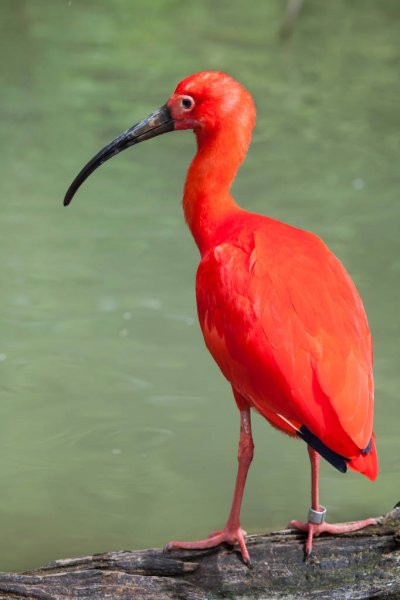ANIMAL: Scarlet Ibis Eudocimus ruber Type of Animal: Ibis Habitat: Mangroves/mangrove swamps, mangrove thickets, mudflats, wetlands, shallow lakes, shorelines, estuaries, bays, marshes, swamps, ponds, isolated islands, rainforest, llanos, tropical grassland plains, marshy lakes, dense brush-covered islands, coastal areas, utilize fresh, brackish, & saltwater Location(s): N South America, Netherlands Antilles, Trinidad, & Tobago w/ disjunct population in Baixada Santista district of SE Brazil. Vagrant throughout South America, Central America, Caribbean, & Florida. Appearance: Adults have pink to scarlet plumage, juveniles mix of gray/brown/white, older juveniles/immatures have gray/brown/white mix w/ touches of red/pink, long narrow decurved bill, long legs/neck Food/Diet: Crustaceans, fish, mollusks, worms, amphibians, insects, insect larvae, small snakes, algae Status in Wild: Stable as a whole. Population in SE Brazil Critically Endangered. Conservation: Breeding in zoos, aquariums, & wildlife centers. Protected by Migratory Bird Treaty Act. Close monitoring of critically endangered population in SE Brazil’s Baixada Santista district near Santos. Caroni Swamp of Trinidad designated to protect these birds in 1953. Lifestyle: Breeding colonies range from 30-1,200 birds. Flocks usually number around 30-40 birds. Additional Info: Called: Male: Cock Female: Hen Young: Chick Group: Colony/Congregation Weight: Male: 3.086 lbs Female: 2.425 lbs Young: 6.278 oz Gestation: 1 month Life Span: 15-20 years Height: Male: 2-2.083 ft Female: 1.75-1.83 ft Body Length: Male: 2-2.083 ft Female: 1.75-1.83 ft Tail Length: 5-6 in, same for both sexes Main predators are procyonids, snakes, felids, raptors, crows, monkeys, & crocodilians. Curved slender bill used for probing. Quiet birds, only grunting/croaking on breeding grounds. In flight, they form diagonal lines or V-formations. Females have 1.7 ft wingspan, males have 1.84 ft wingspan. Often found in colonies/flocks w/ other waterbird species. Males attract females by preening, shaking, bill popping, head rubbing, & high flights. Females lay 2-6 eggs per clutch & can breed up to 3 times a year. Chicks stay w/ parents for 11 weeks & become sexually mature at 1.5 years old. Build loose stick nests on trees. Siblicide not uncommon w/ larger chicks sometimes killing smaller chicks. Fun Fact(s): American author James Hurst used this bird as literary symbol to compose 1960 short story The Scarlet Ibis. Brilliant scarlet color comes from carotene found in crustaceans it eats. One of 2 national birds of Trinidad & Tobago. Sometimes hybridize w/ American White Ibises in areas where 2 species meet.
